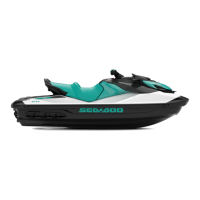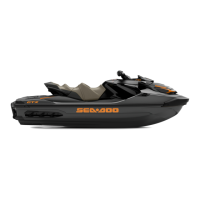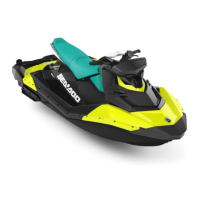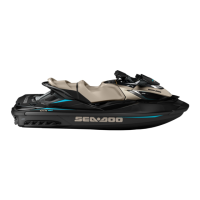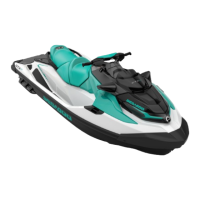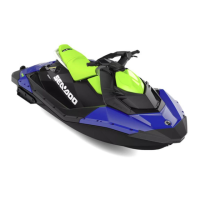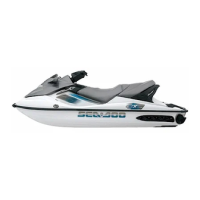Section 11 HULL/BODY
Subsection 02 (3D SERIES)
Remove front protective film once decal has ad-
hered to hull.
INSTALLATION ON PLASTIC (storage cover)
Clean surface with isopropyl alcohol and dry thor-
oughly.
Using a pencil and the decal as a template, mark
the area where decal will be located.
CAUTION: Do not use soapy water to locate de-
cal on plastic parts.
Remove back protective film from decal and care-
fully align decal with marks. When well aligned
squeegee decal beginning at center and working
outward using firm, short, overlapping strokes.
Remove front protective film once decal has ad-
hered.
HULL AND BODY REPAIR
General
Gelcoat is the smooth and durable cosmetic fin-
ish which coats the fiberglass hull and body of a
Sea-Doo watercraft. It also provides a protective
barrier against water and sun. It consists of a mix-
ture of resin, pigment (coloring), fillers, monomers
and catalyst which is sprayed into the mold.
The body and hull of the Sea-Doo are constructed
of chopped fiberglass, saturated with resin. It is
sprayed on the layer of gelcoat along with pieces
of fiberglass mat, cloth and woven roving which
are added at required areas. This type of con-
struction is very accommodating for high quality
repairs. With patience, the proper techniques and
materials, a damaged area can be restored to an
original finish.
NOTE: Fiberglass repair kit is available through au-
tomotive or marine suppliers. Gelcoat repair kits
are available directly from GELCOTE INTERNA-
TIONAL LTD.
WARNING
Protect skin, wear gloves when in contact
with resin, hardeners and gelcoat. A barrier
skin cream may also be used. Do not expose
area to open flame or lit cigarette. Some of
the materials are flammable. Protect eyes,
wear safety glasses when grinding, sanding
or spraying. Use a dust mask when sanding
or grinding. When spraying wear a respi-
rator or paint mask. Always read warning
labels on products.
Air Bubbles
Possible cause:
– Air pocket trapped between layers of laminate
and gelcoat.
PREPARATION OF SURFACE
Remove all of the damaged gelcoat surrounding
the air bubble with a putty knife or preferably a
carbide grinding tip. Make sure all loose and weak
areas are completely removed. Sand a small area
of the gelcoat surface with 220-grit sandpaper. If
needed, sand the cavity itself. These areas must
have a rough surface to allow the gelcoat putty to
bond properly.
FILLING THE CAVITY
The prepared surface must be cleaned with ace-
tone on a cloth. Use a gelcoat repair kit. Follow
the mixing instructions in the kit when preparing
the gelcoat putty.
Carefully mix the required amount while making
sure there are no air bubbles in the mixture. With
a putty knife, fill the repair area and cover with
plastic film. Curing time may depend on temper-
ature, amount of putty and percentage of catalyst.
After 2 hours, press lightly on the surface with
fingers to test the hardness. When the area be-
comes hard, remove the plastic film.
SANDING
Beginblocksandingthepatchwith320-gritsand-
paper until you come close to the original sur-
face. Remove dust with a water soaked cloth and
continue sanding with a 400-grit wet paper. Fin-
ish wet sanding with a 600-grit to remove deeper
scratches. If needed you can wet sand with finer
grit paper such as 1000-grit.
348 smr2005-069

